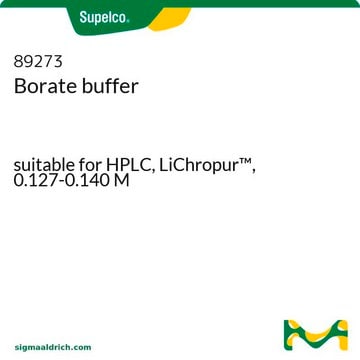B2645
Acido borico
tablet, 1 g boric acid per tablet
About This Item
Prodotti consigliati
Tensione di vapore
2.6 mmHg ( 20 °C)
Livello qualitativo
Saggio
≥95% (titration)
Forma fisica
tablet
pH
5.1 (25 °C, 1.8 g/L)
Punto di fusione
160 °C (dec.) (lit.)
Solubilità
water: 1 tablet/100mL, clear, colorless
Temperatura di conservazione
room temp
Stringa SMILE
OB(O)O
InChI
1S/BH3O3/c2-1(3)4/h2-4H
KGBXLFKZBHKPEV-UHFFFAOYSA-N
Cerchi prodotti simili? Visita Guida al confronto tra prodotti
Categorie correlate
Applicazioni
- Effect of Boron Content in LiOH Solutions on the Corrosion Behavior of Zr-Sn-Nb Alloy.: This study investigates how varying boron content in lithium hydroxide solutions affects the corrosion behavior of Zr-Sn-Nb alloys, highlighting the potential implications for materials used in nuclear reactors (Zhao et al., 2024).
- Evaluation of living bacterial therapy assisted by pH/reactive oxygen species dual-responsive sodium alginate-based hydrogel for wound infections.: This research evaluates a boric acid-containing hydrogel for its effectiveness in treating wound infections through pH and reactive oxygen species responsiveness, indicating innovative applications in wound care (Miao et al., 2024).
Ricostituzione
Avvertenze
Danger
Indicazioni di pericolo
Consigli di prudenza
Classi di pericolo
Repr. 1B
Codice della classe di stoccaggio
6.1D - Non-combustible acute toxic Cat.3 / toxic hazardous materials or hazardous materials causing chronic effects
Classe di pericolosità dell'acqua (WGK)
WGK 1
Punto d’infiammabilità (°F)
Not applicable
Punto d’infiammabilità (°C)
Not applicable
Dispositivi di protezione individuale
Eyeshields, Gloves, type P3 (EN 143) respirator cartridges
Choose from one of the most recent versions:
Possiedi già questo prodotto?
I documenti relativi ai prodotti acquistati recentemente sono disponibili nell’Archivio dei documenti.
I clienti hanno visto anche
Il team dei nostri ricercatori vanta grande esperienza in tutte le aree della ricerca quali Life Science, scienza dei materiali, sintesi chimica, cromatografia, discipline analitiche, ecc..
Contatta l'Assistenza Tecnica.







